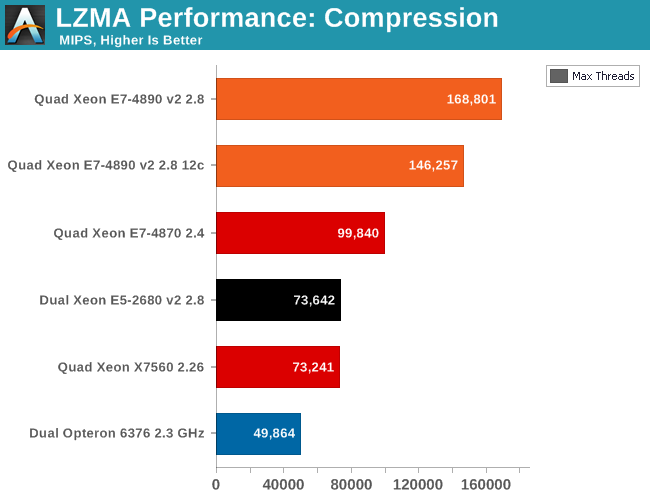The Intel Xeon E7 v2 Review: Quad Socket, Up to 60 Cores/120 Threads
by Johan De Gelas on February 21, 2014 6:00 AM EST- Posted in
- IT Computing
- Intel
- Xeon
- Ivy Bridge EX
- server
- Brickland
Multi-Threaded Integer Performance
How do the new Xeon E7 v2 chips compare to the existing Xeon servers when it comes to some multi-threaded workloads?

When it comes to raw integer processing, the new Xeon delivers up 70% better performance than the previous generation and up to 2.3x better performance than the Xeon X7560. With only 12 cores active to simulate performance of the 12-core models, e.g. E7-8857 v2 and E7-4860 v2, we can get a rough idea how the interesting 3GHz 12-core E7-8857 v2 performs, which has the same TDP (130W) as the previous generation. In those circumstances the new Xeon E7 v2 is 50% faster than the previous generation and twice as fast as the Xeon 7560 (and the actual E7-8857 v2 will be clocked slightly higher).

Decompression gives a similar performance landscape, though the E5-2680 now drops below the X7560.










125 Comments
View All Comments
JohanAnandtech - Friday, February 21, 2014 - link
I don't see the error. "Beckton" (Nehalem-EX, X7560) is at 2.4 GHzmslasm - Sunday, February 23, 2014 - link
> I don't see the error.The article says "The Opteron core is also better than most people think: at 2.4GHz it would deliver about 2481 MIPs." - but, according to the graph, Opteron already delivers 2723 @ 2.3Ghz. So it is puzzling to see that it "would" deliver less MIPS (2481 vs 2723) at higher frequency (2.4 vs 2.3 Ghz) (regardless of any Intel results/frequencies)
silverblue - Saturday, February 22, 2014 - link
It's entirely possible that the score is down to the 6376's 3.2GHz turbo mode.plext0r - Friday, February 21, 2014 - link
Would be nice to run benchmarks against a Quad E5-4650 system for comparison.blaktron - Friday, February 21, 2014 - link
... you know you can't, right?blaktron - Friday, February 21, 2014 - link
Nevermind, read v2 there where you didn't write it. Too much coffee....usernametaken76 - Friday, February 21, 2014 - link
For the more typo-sensitive reader (perhaps both technically astute and typo-senstive):"A question like "Does the SPARC T5 also support both single-threaded and multi-threaded applications?" must sound particularly hilarious to the our technically astute readers."
...to the our...
JohanAnandtech - Friday, February 21, 2014 - link
Fixed. Thx!TiGr1982 - Friday, February 21, 2014 - link
From the conclusion:"The Xeon E7 v2 chips are slated to remain in data centers for the next several years as the most robust—and most expensive—offerings from Intel."
I don't think it will be really "several" years - maybe 1-2 years later this Ivy Bridge-EX-based E7 v2 will probably be superseded by Haswell-EX-based E7 v3 with Haswell cores with AVX2/FMA, which should make a difference in pro floating point calculations and data processing, and working with DDR4.
Kevin G - Friday, February 21, 2014 - link
The Ivy Bridge-EX -> Haswell-EX transition will mimic the Nehalem-EX -> Westere-EX transition in that the core systems provided by the big OEM will stay the same. The OEM's offer Haswell-EX as a drop in replacement to their existing socket 2011v1 systems. Haswell-EX -> Broadwell-EX will again be using the same socket and follow a similarly quick transition. SkyLake-EX will bring a new socket design (perhaps with some optical interconnects?).At some point Intel will offer new memory buffer chips to support DDR4. This will likely require a system to swap out all the memory daughter cards but the motherboard from big OEM's shouldn't change. There may also be a period where these large systems can be initially configured with either DDR3 or DDR4 based upon customer requests.